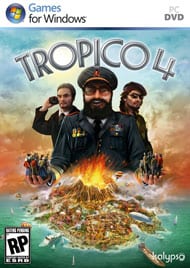Today Tropico, Tomorrow The World
It hasn’t even been two years since Tropico 3 came out, so Tropico 4 might feel a little premature to longtime fans. I suppose that’s fair; the last time two Tropico games came out within a two-year period, it didn’t go very well. The result was Tropico 2: Pirate Cove, which a lot of fans don’t even consider to be a Tropico game.
Yet here we are, with Tropico 4 already in our hands.
Thankfully, Tropico 4 managed to stay out of Pirate Cove, and it should feel familiar to anyone who has played Tropico 3. For those who haven’t experienced Tropico before, it’s a series of city-building sims that might be a bit reminiscent of SimCity. However, one could hardly call Tropico a SimCity clone; it definitely has its own identity. The major difference here is the Cold War era Caribbean location, which brings a completely different tropical vibe to the game. Tropico also carries its own unique brand of dark humor. You will laugh at the misery of your islanders, but you won’t feel too bad about being such a horrible person, because the writing has so much wit and charm. And that’s really what the Tropico games do right: they make being a horrible person seem incredibly fun.
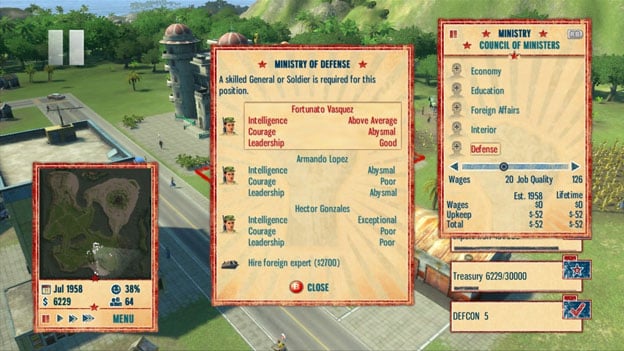
Returning in Tropico 4 is El Presidente, the character that you will step into the shoes of for the duration of the game. You will decide exactly how you want to run your little slice of paradise. What if your people don’t agree with you? Well, those people can be dealt with. As El Presidente, bribery, propaganda, imprisonment, and even murder are the tools at your disposal. Use them wisely or risk losing your position (and your wonderful Swiss bank account).
But Tropico 4 does manage to push the formula forward in a lot of ways. Most noticeable is the updated look. The nation of Tropico is seeping with natural beauty, and Tropico 4 succeeds at presenting it much better than its predecessors. Tropico 3 had far too much green and brown in its palate, but Tropico 4 shows us a world vibrant with colors. As an added bonus that many players might not even notice, there’s a chance that you could put down two copies of the same building—a tenement, say—right next to each other, and each would be a different color. This fact alone goes a long way in making the game world not feel so “cut and paste.”
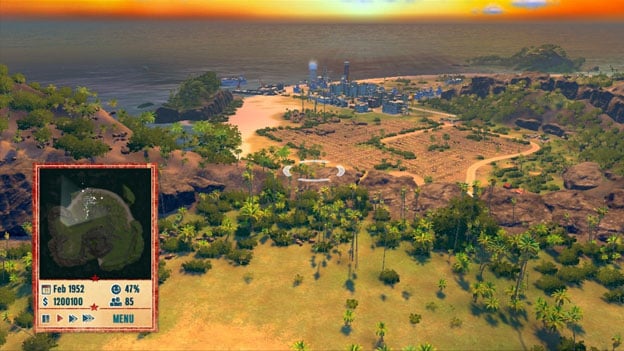
Riffing off the series’ unique brand of humor, Tropico 4’s characters have their own portraits, and they look like extremely exaggerated caricatures. Even when they are delivering bad news, you’ll still laugh just seeing their goofy-looking faces. While these characters remain mostly in the background, each manages to display an incredibly unique—though often stereotypical—personality. You will get to actually know these characters a little bit, which, considering Tropico’s excellent writing, is a very welcome addition to the series.
Of course, any attempt at character development could have fallen flat if the voice work didn’t ring true, but Tropico 4’s voice acting is top-notch. If a character sounds exaggerated, it’s because they are supposed to sound exaggerated. My personal favorites are Miss Pineapple, the flirtatious head of the intellectual faction, and Keith Preston, a wealthy southerner stereotype. Of course, my least favorite is easily Sunny Flowers, the hippy surfer chick who is always ragging on me about protecting the environment.
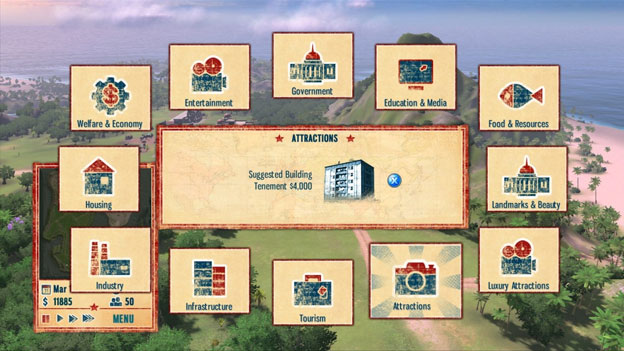
The story mode includes twenty missions that each task you with a specific goal. For example, the goal of the first mission is to win an election, and another early mission has you try to gain one million followers on a certain social network. Once you accomplish your major goal, you have the choice to either continue playing the world you have worked so hard to build or skip to the next mission, which will start you fresh in a new location.
There are two new twists that make Tropico 4’s campaign far better than previous games in the series. The first is the added character development, which I’ve already mentioned. The second is that alongside your main goal, there are several optional side missions you can take, and often these will help you accomplish your major goal sooner. Some of the things you’ll be asked to do include exporting 500 units of beef, building a specific monument, and “lending” a bunch of money to one of the world’s superpowers (usually the U.S.S.R.)
Oh yes, The U.S. and U.S.S.R. are back as superpowers, but they are joined by Europe and the Middle East. This means that trying to keep them all happy at once will be more difficult. Here’s a hint: Only the U.S. and the U.S.S.R. give you financial aid, so you’ll probably want to keep those guys a little happier than the others. On the other hand, the Middle East is known for its itchy trigger finger…
Some of these missions could take you two or three hours, or even longer if you choose to stick around for a while to maybe finish up some extra side missions. When you add it all up, you could easily spend dozens of hours on the campaign alone. Of course, you can also design your own campaign. While you don’t have freedom over the basic layout of your island, you get to modify the terrain, decide which crops should grow better where, lay down your own ore deposits, and decide which buildings and how much money you start out with. When you’re done, you can upload them to the internet or download islands others have made. And then there’s always Sandbox mode, which has you freely build and micromanage your island with no major goal. Suffice to say, Tropico 4 has a very satisfying amount of content.
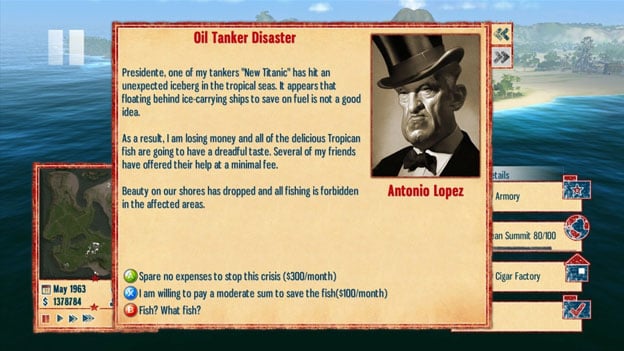
Though I can’t say much about the Xbox 360 version, the PC controls are classic Tropico. Right click to open your build menu, left click to place a building, use the scroll wheel to rotate structures, and so on. My only complaint is that building roads functions exactly how it did in Tropico 3—it’s admittedly a little bit awkward. If you’re like me and want your roads to lie in perfect grid patterns, you’re really going to have to work to make that happen. They always seem to want to curve rather than make right angles, and putting them down on terrain that isn’t perfectly flat can lead to some weird road patterns.
One other new feature I should make mention of is the option to hire ministers to help you pass various forms of legislation. This isn’t actually as game-changing as it sounds, as it’s really just an extra prerequisite to putting certain edicts into play. While you will need to rely on these ministers at a few crucial points in the campaign, you probably won’t look to them all that much until you get pretty deep into the micromanagement aspects of the game. In fact, during several missions, I completely forgot they were even there.
Tropico 4 honestly doesn’t do a whole lot different than Tropico 3. But that’s not necessarily a bad thing; Tropico 3 was a glorious return to the gameplay style of the original game, after all. While Tropico 4 may not be a huge leap for the series, it polished and fine-tuned its mechanics and visual appeal well enough to make another trip to Tropico a meaningful one. And I’d definitely say that this Tropico has the most personality of the bunch. It’s just bursting at the seams with dark humor that often borders on political satire.
The bottom line: if you have never experienced a Tropico game before, Tropico 4 is simply the best the series has to offer. If you’ve been playing the series since it first began, Tropico 4 has refined its formula nearly to perfection, and is worth your time for the new characters and missions alone.
RATING OUT OF 5 RATING DESCRIPTION 4.0 Graphics
The most colorful Tropico yet, with the addition of hilarious character portraits. 3.8 Control
Tropico as it’s always been. 4.2 Music / Sound FX / Voice Acting
Classic Tropico-style music and sounds, with some absolutely brilliant voice work. 4.3 Play Value
Tropico 4’s campaign alone is an incredibly meaty experience that you could easily lose yourself in for forty hours or more. And you can always build your own challenges or play the Sandbox mode as well. 4.2 Overall Rating – Great
Not an average. See Rating legend below for a final score breakdown.
| Review Rating Legend | |||
|---|---|---|---|
| 0.1 – 1.9 = Avoid | 2.5 – 2.9 = Average | 3.5 – 3.9 = Good | 4.5 – 4.9 = Must Buy |
| 2.0 – 2.4 = Poor | 3.0 – 3.4 = Fair | 4.0 – 4.4 = Great | 5.0 = The Best |
Game Features:
